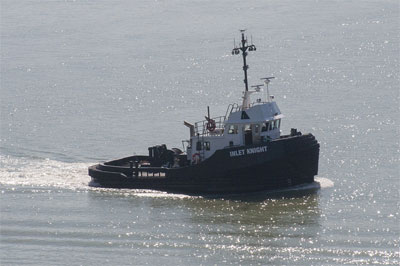It was log towing that defined the British Columbia towing industry. Now a new tug from a design by A.G. McIlwain Ltd. may be redefining the business. Since the province of British Columbia lifted restrictions on the export of raw logs, there has been a demand to move ever-larger volumes of wood from the up-coast forests to the ports where the log ships line up to take the unprocessed wood to Asia.
Some towing companies have been pressing older single-screw vessels into service to take part in the flow of business. Unlike so much of modern towing, log towing is not all about horsepower. These big rafts of bundled logs can’t be pulled with the full force of 5,000 or even 3,000 hp. They are held together with boom sticks, chains and cables; and too much bollard pull can rip them apart, creating the need to round up all the free-floating log bundles.
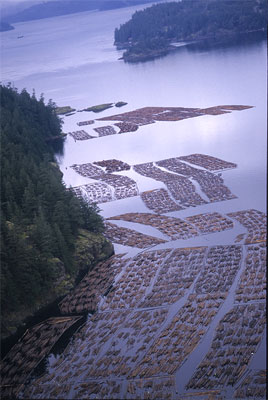 |
|
Log booms in Gowlland Harbour near Campbell River. |
A good log tug will exert a steady pull, but it will also be very dependent on a skipper who understands how to use the tides to good effect while avoiding heavy weather that could break a boom and scatter the logs for miles. Capt. Adam Sweeney operates the 2012-built tug Inlet Knight for Gowlland Towing based in Campbell River on Vancouver Island.
The 58-foot-11-inch-by-26-foot-6-inch Inlet Knight was delivered to the owner, Gowlland Towing, by Sylte Shipyard on the Fraser River in early 2012 and went right to work. While the tug has done some barge work, the primary focus has been on log booms.
In mid-March, Sweeney returned to his family in Campbell River after a typical tow. The tug and its crew started at the entrance to Seymour Inlet, about 240 miles northwest of Vancouver and across Queen Charlotte Sound from the north end of Vancouver Island. A smaller tug had brought them a 19-section boom out through the notorious Nakwakto Rapids. Each section is a square of floating logs defined by 60-foot boom sticks that enclose the log bundles in a raft which is secured to the other sections with massive “boom chains” that are passed through holes augered through each boom stick near its end.
Inlet Knight then towed this boom across to Port Hardy where the tug picked up more sections of logs to make a tow of 72 sections to tow down Johnstone Strait. In order to make time down the strait, a good log tower knows how to hug the shore to take advantage of the back-eddies rather than buck the ebb tide, and then move out to take advantage of the extra push with the flood tide. Inlet Knight is fitted with tow pins on the stern. Sweeney has learned that these impair the steering and tend to set him even more toward the shore when he tries to turn from a back-eddy into the main stream. With the pins down the boat responds very well.
 |
The JonRie InterTech winch, loaded with 2,500 feet of 1.5-inch wire on the after deck, gets good marks from Sweeney, although it took a bit of time to get used to it. Most towing winches let line out by releasing the brake and letting the wire freewheel off the drum, but the JonRie requires that the wire be run out under power. “This is good,” said Sweeney, “especially when running line out with a barge. You never lose control so it doesn’t go shearing off.”
He also likes how the winch can be controlled from any of three single levers, to release the brake and power out or in. One is on the flying bridge control station atop the pilothouse. The other two are located on either side of the winch at deck level. Abort switches are located in the pilothouse, at the top control and on either side of the winch. “If you are in trouble and you want to let your wire freewheel off the drum, it won’t help if the abort is under water,” Sweeney explained.
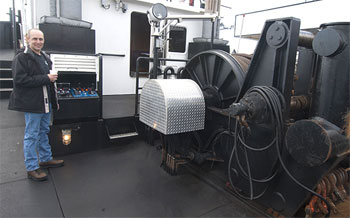 |
|
Capt. Adam Sweeney with the JonRie towing winch controls. |
The hydraulics for the towing winch are taken off the back of the main engines. The two Caterpillar C32 mains each deliver 750 hp to Twin Disc gears with 6:1 reduction. They turn 72-by-65-inch propellers in Kort nozzles. Kobelt shaft brakes are installed just aft of the gear and power takeoff on each side. These come on automatically when shifting from forward to reverse to stop the big props.
“If I ever had to come home on a single engine, I would apply the shaft brake on the one not in use rather than deal with tying the shaft down,” Sweeney explained. He has also found that the system works well to run line to the tow. “I put one engine in neutral and rev it to get hydraulic power for the winch, and then idle ahead on the other to run ahead of the tow.”
Sweeney has nothing but praise for the tug’s operation and enjoyed telling of passing other Vancouver-bound tows after picking up more sections of wood at the company’s storage grounds in Gowlland Harbour across from Campbell River. When they left Gowlland to head south off Cape Mudge, they had a total of 95 sections in the boom.
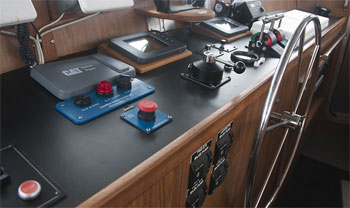 |
|
The well laid out wheelhouse dashboard has Kobelt and Cat controls as well as an abort switch for the towing winch. In addition to good functionality, the pilothouse has a very pleasing appearance. The teak wood trim of the interior gives the new tug a yacht-like look and feel. |
“The boom was made up with five sections wide,” recalled Sweeney. “We crossed over above Mitlenatch Island to Bakers Pass on the mainland side for better shelter, but in the open it was blowing about 15 knots. We had put a lot of extra gear on the tow to strengthen it, and we were able to make 1.8 knots with the engines turning at 1,730 rpm.”
At that speed, even the 10 or 11 nautical miles from Cape Mudge to Baker Pass leaves the boom exposed to possible heavy weather for about five hours. When towing log booms, the shortest route is not always the safest. But Sweeney was pleased with his decisions and was able to pass a couple of other tows as he made his way south, first to Howe Sound, where he left some sections, and then over to the Fraser River, where he left the rest. “We left Campbell River at 0230 on March 16 and went nonstop to Howe Sound in 55 hours. We arrived there at 0930 on March 18.”
After dropping some sections in Howe Sound, the three-man crew of Inlet Knight took the rest of the tow a little over 15 nautical miles to the North Arm of the Fraser River. “We were headed home at 0230 on March 19. We make 9 knots running light at 1,550 rpm and burning 34 U.S. gallons per hour. We can do 10.4 knots at 1,800 rpm, but burn 60 gallons per hour. The electronic engines give us a fuel display so we can gauge fuel burn and relate it to an economic speed much more easily now.”
Running light, the log towers were able to take the more direct route home and arrived in Campbell River at 1300 on the same day. With a couple of days to relax with his family, Sweeney took time to praise the Sylte Shipyard for the yacht-like interior of the new tug with its teak wood trim. The boat has a well-equipped galley on the port side and a comfortable mess area on the starboard side of the large main cabin, leaving ample deck space on either side. Five steps connect the galley and the well-equipped wheelhouse with windows providing a view aft when towing. For making up to a tow, a flying bridge above the wheelhouse gives a full 360° view. In the forecastle, two staterooms provide two single bunks each and a well fitted out head with shower.
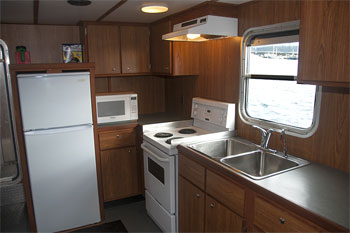 |
|
The tug has a well equipped full-size galley on the port side and a comfortable mess on the starboard side. |
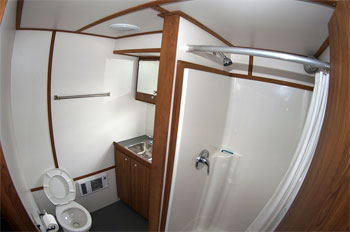 |
|
Each of the two-person staterooms shares a head with a shower. All the crew spaces feature attractive teak woodwork. |
Most of the logs that the new tug will tow come out of the many long mountain-lined inlets that indent the British Columbia coast. One of them, the spectacular Knight Inlet, is the origin of the name for the new tug. Log towing may be slow, but a day at sea is still a day at sea, and there is plenty of comfort on board Inlet Knight to make the going pleasant.

